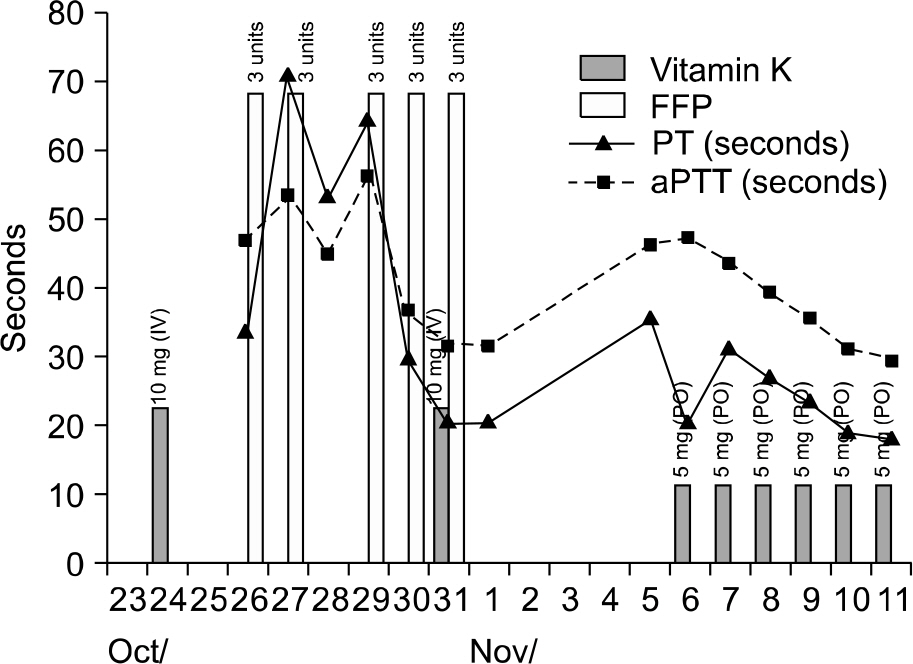Korean J Hematol.
2009 Mar;44(1):53-57. 10.5045/kjh.2009.44.1.53.
A Case of Superwarfarin Intoxication without a Definitive History of Brodifacoum Exposure
- Affiliations
-
- 1Department of Internal Medicine, Chungbuk National University Hospital, Cheongju, Korea. stkim@chungbuk.ac.kr
- 2Department of Internal Medicine, Chungbuk National University School of Medicine, Cheongju, Korea.
- 3Chungbuk National University Medical Research Center, Cheongju, Korea.
- KMID: 2252175
- DOI: http://doi.org/10.5045/kjh.2009.44.1.53
Abstract
- Superwarfarin intoxications that induce profound and prolonged coagulopathy are being increasingly reported, to such an extent that it is becoming a comparatively common intoxication. However, there have been few reported cases of superwarfarin intoxication with an inadvertent cause or an unknown origin. A 58-year-old man with recurrent painless hematuria was found to have an acquired deficiency of vitamin K dependent clotting factors, and a large amount of vitamin K was required to correct the coagulopathy. He had no history of warfarin use or any exposure to rodenticides, but brodifacoum was detected in his serum. It is important for physicians to be aware that significant coagulopathy can occur secondary to superwarfarin intoxication, without any known exposure to substances that might induce this.
Keyword
MeSH Terms
Figure
Cited by 1 articles
-
Korean Patients with Superwarfarin Intoxication and Their Outcome
Junshik Hong, Ho-Young Yhim, Soo-Mee Bang, Sung Hwa Bae, Young Jin Yuh, Sung-Soo Yoon, Hwi-Joong Yoon, Seung Taik Kim, Hyun-Sook Chi
J Korean Med Sci. 2010;25(12):1754-1758. doi: 10.3346/jkms.2010.25.12.1754.
Reference
-
References
1. Berry RG, Morrison JA, Watts JW, Anagnost JW, Gonzalez JJ. Surreptitious superwarfarin ingestion with brodifacoum. South Med J. 2000; 93:74–5.
Article2. Weitzel JN, Sadowski JA, Furie BC, et al. Surreptitious ingestion of a long-acting vitamin K antago-nist/rodenticide, brodifacoum: clinical and metabolic studies of three cases. Blood. 1990; 76:2555–9.
Article3. Corke PJ. Superwarfarin (brodifacoum) poisoning. Anaesth Intensive Care. 1997; 25:707–9.
Article4. Mack RB. Not all rats have four legs. Superwarfarin poisoning. N C Med J. 1994; 55:554–6.5. Spahr JE, Maul JS, Rodgers GM. Superwarfarin poisoning: a report of two cases and review of the literature. Am J Hematol. 2007; 82:656–60.
Article6. Nelson AT, Hartzell JD, More K, Durning SJ. Ingestion of superwarfarin leading to coagulopathy: a case report and review of the literature. Med Gen Med. 2006; 8:41.7. Pavlu J, Harrington DJ, Voong K, Savidge GF, Jan-Mohamed R, Kaczmarski R. Superwarfarin poisoning. Lancet. 2005; 365:628.
Article8. Rauch AE, Weininger R, Pasquale D, et al. Superwarfarin poisoning: a significant public health problem. J Community Health. 1994; 19:55–65.
Article9. Laposata M, Van Cott EM, Lev MH. Case records of the Massachusetts General Hospital. Case 1–2007. A 40-year-old woman with epistaxis, hematemesis, and altered mental status. N Engl J Med. 2007; 356:174–82.10. Abell TL, Merigian KS, Lee JM, Holbert JM, McCall JW 3rd. Cutaneous exposure to warfarin-like anticoagulant causing an intracerebral hemorrhage: a case report. J Toxicol Clin Toxicol. 1994; 32:69–73.11. Kim HY, Jeon HJ, Ko BS, Lee KH, Kim ST. Two cases of brodifacoum poisoning from inhalation route. Korean J Hematol. 1996; 31:473–9.12. Bruno GR, Howland MA, McMeeking A, Hoffman RS. Long-acting anticoagulant overdose: brodifacoum kinetics and optimal vitamin K dosing. Ann Emerg Med. 2000; 36:262–7.
Article13. Zupancić-Salek S, Kovacević-Metelko J, Radman I. Successful reversal of anticoagulant effect of super-warfarin poisoning with recombinant activated factor VII. Blood Coagul Fibrinolysis. 2005; 16:239–44.14. Hollinger BR, Pastoor TP. Case management and plasma half-life in a case of brodifacoum poisoning. Arch Intern Med. 1993; 153:1925–28.
Article15. Tsutaoka BT, Miller M, Fung SM, Patel MM, Olson KR. Superwarfarin and glass ingestion with prolonged coagulopathy requiring high-dose vitamin K1 therapy. Pharmacotherapy. 2003; 23:1186–9.
- Full Text Links
- Actions
-
Cited
- CITED
-
- Close
- Share
- Similar articles
-
- Evaluation of risk factors in patients with vitamin K-dependent coagulopathy presumed to be caused by exposure to brodifacoum
- Korean Patients with Superwarfarin Intoxication and Their Outcome
- A Case of Prolonged Coagulopathy in a Patient Intoxicated with Superwarfarin Rodenticide
- Can we more efficiently save patients with vitamin K-dependent coagulopathy caused by superwarfarin intoxication?
- A Case of Massive Levothyroxine Intoxication in a Patient with Total Thyroidectomy



